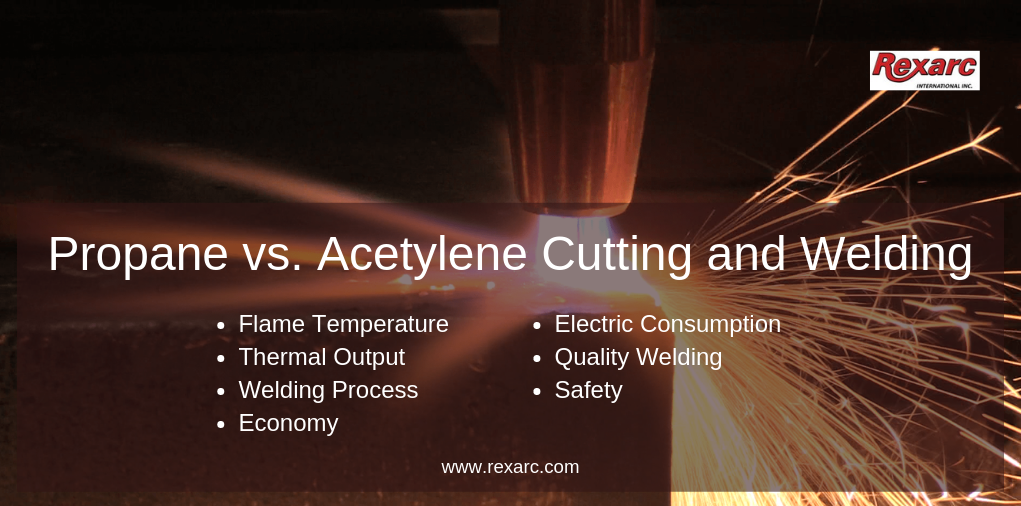Welding is one of the intricate manufacturing processes used in various industries. The process may vary largely according to the material that is being considered for welding, magnetic or non-magnetic, ferrous or non-ferrous material, and so on. Gases are one of the integral components of welding, and today various types of gases are used for the purpose. The consideration of the material will also influence your decision on the type of gas to be used for welding. The two popular types of gases used for welding includes shielding gases and fuel gases. Helium, carbon dioxide, and argon are a few important types of shielding gases used for welding, whereas propane, acetylene, and propylene are important types of fuel gases. This post concentrates on two important types of fuel gases used for welding— propane and acetylene, their advantages, and disadvantages.
A Brief Discussion on Key Differences between Propane Welding and Acetylene Gas Welding
The following are some major differences that will help you understand how propane welding and acetylene gas welding differ from each other.
- Flame Temperature: Both these gases are combined with oxygen to create the desired profile suitable for welding different types of metals. Propane, also referred to as LP gas or Liquefied Petroleum Gas, when mixed with oxygen generates a flame temperature of 2800 degree Celsius. However, acetylene on mixing with oxygen generates a flame temperature of 3100 degree Celsius. High flame temperature and excellent flame impingement characteristics of acetylene are being exploited for welding or cutting the rounded edges of any metal. The hotter flame temperature will allow quick piercing of tough materials.
- Thermal Output: Acetylene and propane are also differentiated based on their thermal outputs. The British Thermal Unit (BTU) value of acetylene is 1470 per cubic feet, whereas propane has a BTU value of 2498 per cubic feet. Even if acetylene has a higher flame temperature than propane it doesn’t mean that the latter produces any less heat. Although oxy acetylene combination assures a faster preheating than propane, most of the preheating in welding is performed with propane-oxygen. This is because propane is cheaper and capable of producing a high amount of heat necessary for pre-heat.
- Welding Process: Firstly: Propane gas cannot be used for gas welding. When acetylene burns in oxygen, it creates a reducing zone that cleans the steel surface. Propane does not have a reducing zone like acetylene and hence cannot be used for welding.
Why Acetylene is used as a Welding Gas?
There are several reasons why acetylene has become a popular welding gas over propane.
- Safety: This is one of the prime requirements of any manufacturing process, and welding is no exception. The flammability limit of acetylene in the air is 2.5% to 82%, whereas that of propane is 2.1% to 9.5%. This may lead to a conclusion that acetylene is more dangerous than propane; however, the same is not true. Acetylene’s specific gravity 0.9 so it is lighter than air. If gas leaks out it will rise. The specific gravity of propane 1.6 and heavier than air. Any propane leak in an enclosed area will sink and become concentrated at deck level, accumulate and sometimes avoid detection. Acetylene is stored in a porous mass and acetone inside a cylinder, which assures its 100% safe storage.
- High Quality Welding: It is a well-known fact that acetylene produces a sharp and focused flame more than propane. Propane generates less than 10% thermal energy, whereas acetylene generates 40% of thermal energy in the inner flame cone. This helps ensure better weld quality and cutting using oxy acetylene.
- Helps Reduce Electric Consumption: Nowadays, high strength steel materials are used in various industries, especially the automotive industry. The structural complexity of steel materials, and precision required while welding or cutting these steel materials has made electric welding a preferred choice among welders. With increasing concerns on reducing electric consumption, welders have again started using oxy acetylene welding, as it requires no power supply, and can be used for welding most types of high-strength steel materials.
- Economy: Propane has greater stoichiometric oxygen requirements than acetylene. For maximum flame temperature in oxygen, the ratio volume of oxygen to fuel gas are 1.2 to 1 for acetylene and 4.3 to 1 for propane. So, there is far more oxygen being consumed when using propane than acetylene. Despite propane being less expensive than acetylene, this is counteracted by the higher oxygen consumption.
All the above-discussed points will help you understand how acetylene welding always scores over propane welding. Acetylene gas welding is nowadays accomplished using acetylene gas cylinders. It is important that you source these cylinders from a reliable manufacturer.




